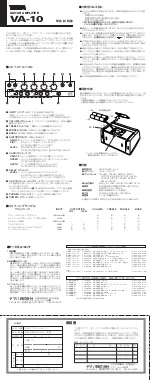
LMA8 Mic/Line Preamplifier
2
Features
•
8 microphone inputs at the back panel
•
8 high impedance instrument inputs at the front
•
8 balanced line outputs at the back panel
•
8 balanced insert points at the back panel
•
Insert points are selectable from the front panel
•
Switching done by sealed gold contact relays
•
Ultra low noise
•
Ultra low distortion
•
+30 dBu input headroom
•
Automatic switching between instrument input
and mic input
•
Exceptionally open and transparent sound
•
Input circuit has vacuum tube characteristics
•
True balanced architecture throughout the unit
•
Smooth gain adjustment from +10 dB to +70 dB
by potentiometer, no clicks
•
Built-in +48 Volts Phantom Power
•
Linear low noise power supply. No Swichmode!!
•
Slot for optional USB or AES digital interface.
•
Inputs and outputs are ESD protected to 23 kV,
IEC 61000-4-2 and 15 A surge, IEC 61000-4-5.
•
Sturdy steel metal casing, electrically and
magnetically screened.
•
Stand-alone desktop or with mountable 19” rack
mount flanges
•
Affordable price.
General description
The LMA8 is an 8 channel ultra low noise and ultra low
distortion mic/line preamplifier designed with the
professional sound engineer in mind. The unusual large
input headroom of +30 dBu enables the amp to handle
fast transient and large dynamic sound pressure
changes with ease. At the same time it reproduces
micro-details and environmental depth perspective with
a natural openness and impressive accuracy.
The circuit is designed so input clipping cannot be
experienced. The input circuit has a clipping limit at
+30 dBu, and because there is always at least +10 dB of
gain in the signal path, the output (or the connected
equipment) will simply always clip before the input.
The LMA8 is a purist's dream come true. The design is
based on a very stringent philosophy, meaning the
shortest possible signal path and the highest possible
quality components. The input circuit is a true class A
differential gain stage, and it has a transfer characteristic
that resembles that of a vacuum tube triode, giving the
unit a natural, relaxed and open sound, yet it maintains
an extremely fast and totally precise response.
The architecture is fully balanced throughout the unit,
which means that the signals between the various
circuits are routed as a positive and a negative signal,
not the standard way of using signal and ground. Ground
is not used to transfer audio signals at all. This
architecture keeps the audio path free from non-linear
distortion from currents running in the ground mesh or
from “non musical” signals from external electrical fields,
power supply noise, crosstalk from other channels etc.
Although the LMA8 is constructed by using modern
day's cutting edge technology, the design philosophy is
inspired by some of the very best preamps that have
been manufactured over the last 50 years.
The basic model is pure analog, aimed at the
professional studios that already have high quality AD
and DA converters available
Optional USB or AES interface modules are available,
using top range digital converters with ultra low distortion
and 120 dB dynamic range
Mic inputs and instrument/line inputs
The amp has 8 separate and identical channels. Each
channel has two inputs, a microphone input and a high
impedance line/instrument input.
The 8 microphone inputs are placed at the back panel
and use one 25 pin D-SUB female connector
The 8 instrument/line inputs are placed at the front panel
for easy access and use 1/4" standard Jack connectors
Switching between line input and mic input is automatic.
When no Jack is plugged into the front connector, the
mic input at the back is active. When a Jack is plugged
into the front connector, the unit disables the mic input at
the back, activates the line input at the front, and
switches to high impedance mode. The high impedance
of the line input (1 Mohm/60 pF) is intended for
instruments, like guitar or bass, but it is equally well
suited for line level equipment, such as keyboards and
the like.
Outputs and insert point
Each channel has a buffered balanced line output and a
balanced direct input to the digital modules. Each use
25 pin D-SUB female connectors at the back panel.
The 8 line outputs and the 8 direct inputs form the insert
points, intended for use with analog equipment. These
insert points can be bypassed by pressing the insert
point switches at the front panel.



































